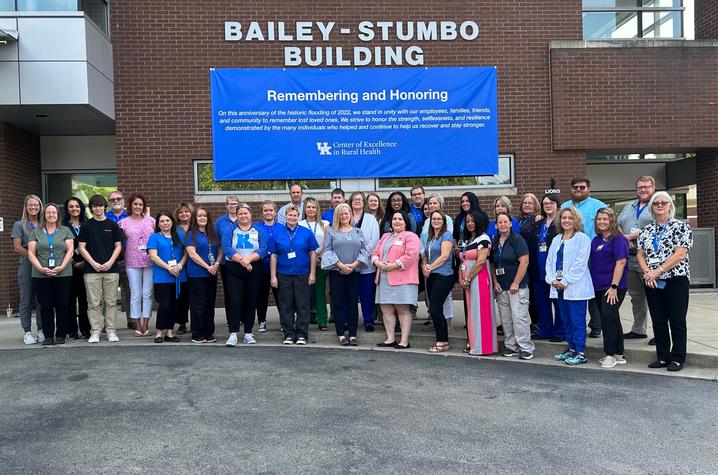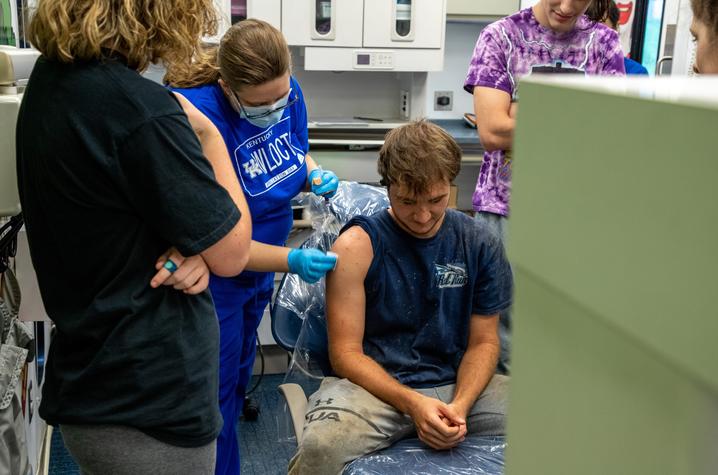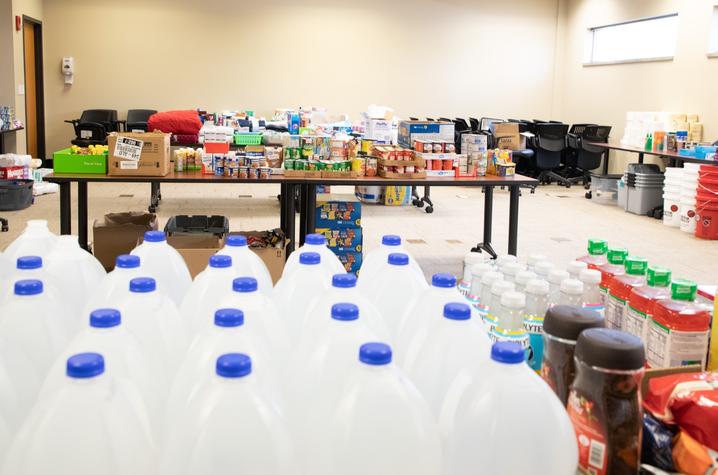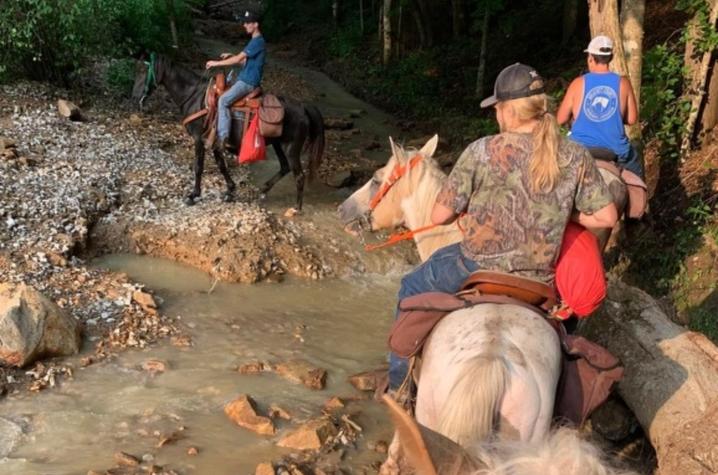UK, UK HealthCare continue support of Eastern Kentucky 1 year after devastating floods
LEXINGTON, Ky. (Aug 2, 2023) — “It seems like it happened yesterday and forever ago at the same time,” said Key Douthitt, M.D., medical director for UK HealthCare’s North Fork Valley Clinic in Hazard, Ky.
It has been one year since Hazard and several other Eastern Kentucky communities were devastated by days of flooding. Portions of communities were virtually wiped away by the waters, with some homes being swept off their foundations and carried away. For those who had the misfortune of being along the path of the historic flooding, pieces of their families’ homes and many of their belongings were scattered along creek banks and even up in trees, showing just how high the water rose. Anything left behind, including the insides of their homes, became caked in layers of mud.
“Some affected by this disaster feel that time has passed by slowly this year getting the resources they need to get back to some sense of normal,” said Fran Feltner, D.N.P., director of the University of Kentucky Center of Excellence in Rural Health. “The Center is pausing during this anniversary to remember the lives lost and to recognize the efforts of so many who have given their time, money, and support for our communities. We strive to honor the strength and selflessness demonstrated by many.”
Douthitt and Feltner were among several UK and UK HealthCare employees who call that region home, and who jumped into action to help their neighbors in the immediate aftermath. They were part of the teams traveling by foot, ATVs and even horseback to get to survivors in those first days. They were joined by other UK HealthCare providers in the area, UK Retail Pharmacy members and others who knew the terrain. The horseback teams were led by members of the Breathitt Horseman’s Association, which is part of the Breathitt County Cooperative Extension. The teams provided tetanus shots, medications, water, first aid and connections with other needed resources.
Their work to help flood survivors has been tireless and continues today. At times they use their field of expertise to help and at other times their compassion as humans drives them to help however they can.
“We just kept hearing about a lot of needs, even at three months out from the flooding. Food, water, and other basic things,” said Melissa Slone, director of research at UK’s Center of Excellence in Rural Health (CERH). Slone used her background in research to put together a needs assessment survey. Several others jumped into action to help with this effort and literally take the survey out to the people impacted.
“We heard that Owsley County had some hard-hit areas, but because of the devastation in the four main counties they were getting very little assistance,” said Slone. As a result, Slone helped organize a team of volunteers, mostly made of UK employees from across various units and members of the local health departments, to go door-to-door in Owsley County.
“Being part of UK really helped when we made the call for volunteers,” said Slone. “Once out there, we heard from some in the area that we were the first people to actually come in where they lived to check on them, which kind of bothered me as we were several weeks out from the flooding.”
Throughout this whole process, Slone has been a firm believer in going to those impacted. She agrees the efforts around resource distribution centers and immediate relief efforts were monumental, but the devastation was so vast and far-reaching that the most rural communities still struggled.
“People who had lost their homes, their cars, potentially their jobs, maybe a loved one - were being told we have resources for you, but they are 45 minutes away and you have to go get them,” she said.
Getting to the victims where they were became a passion for Slone and many others at UK’s CERH. “We just kept thinking, 'We must get out there, and we have to figure out what’s going on.' It motivated us all to at least try to make as much contact as we could,” said Slone.
The needs assessment form asked about things like access to food, water, transportation and basic household items, as well as questions regarding the need for any medical equipment or if there had been changes to their employment status or income following the flooding. The completed surveys were then all compiled into a central database, which helped create an organized and focused effort to help those in need. After going through the impacted areas in Owsley County, additional volunteers from across the University came to Eastern Kentucky and helped perform the assessment in other affected communities.
“We tried to cover it all, from A to Z, what might be needed," said Slone. "We had Kentucky Homeplace on standby for immediate needs and then if someone had a long-term need then we could refer them to the long-term recovery group.”
The long-term recovery group includes Dr. Douthitt, who balances a full patient load in the clinic each day, and is now also in the chair of the housing committee for hard-hit Breathitt County.
It is not a small task, with hundreds of homes destroyed or majorly damaged in that county alone. In 2021, FEMA declared flooding disaster that the county is also still recovering from.
“You sort of feel sometimes like you’re spinning your wheels trying to get things moving in the right direction. But I’m hopeful,” said Douthitt.
Douthitt is helping flood survivors navigate the process of applying for and receiving relief assistance money from the government to get back into permanent housing.
Some of the money can be used for reconstruction. That means someone’s home was destroyed, but they can rebuild on that same plot of land but at a different location on the land. Then other money can be used for what is considered new housing. New housing is for somebody who does not have any land out of the floodplain and must find new property to build on.
“The big issue is there is not a whole lot of land that is suitable,” said Douthitt. “The whole point is to get people out of the floodplain so they are safer from future floods.”
In Eastern Kentucky, it’s common for generations of families to put their homes on the same stretch of land. Douthitt has found many people do not want to leave their property. He says a common refrain: “I was born and raised here, and this is where I’m going to die.”
“We began to understand that mentality,” Douthitt said.
The weight of the daunting task ahead of Douthitt and the housing committee didn’t take long to sink in as they watched people in their communities living in campers, mobile homes, and even tents. They knew they had to get people out of these temporary homes.
“I just started going to unoccupied areas and walking the land to see if there were any flat places we could potentially build a house on," Douthitt said. "First off, that was very time-consuming. Secondly, this was towards the end of the spring following the flooding, and as it got warmer the unkept vegetation grew and became filled with briers. The areas became difficult to get through.”
Dr. Douthitt spent a few weeks trekking through empty properties. “One was 200 acres," he said. "I spent probably about eight hours just walking across it and tracking the terrain.”
Douthitt and others working on this effort were only able to use basic contour maps or satellite imaging services that were easily accessible to them. Unfortunately, many of those maps do not take into account changes to topography due to strip mining and other factors.
“I finally realized, 'I’ve got to try to work smarter and not harder,'” said Douthitt.
The family medicine doctor tapped into his resources as part of the UK family and connected with Doug Curl at UK’s Kentucky Geological Survey.
“I’m so fortunate that as a part of UK I’ve had these resources. We have never felt alone,” said Douthitt.
With the secure database created by UK employees, compiled from surveys created and administered by UK employees, Douthitt partnered up with Curl to try to chip away at the biggest need in the database … housing.
“The state has really, really good geographic information systems (GIS) data. We are able to use what the state of Kentucky gathers from different sources like transportation, FEMA, and other agencies,” explained Curl. His extensive background in mapping allows him to pull all of that data together on top of LiDAR mapping. LiDAR, which stands for Light Detection and Ranging, is a remote sensing method that uses light in the form of a pulsed laser to measure ranges to the Earth. These light pulses — combined with other data recorded by the airborne system — generate precise, three-dimensional information about the shape of the Earth and its surface characteristics.
They then were able to incorporate specific criteria for this project into their mapping.
“We considered areas with a slope less than 10 degrees. That is probably the maximum you could comfortably engineer a house to build on," said Curl. "The area also had to be out of the floodplain and there also was some criteria about proximity to sewer lines, away from buildings, access to roads, and that sort of thing."
The results were eye-opening, but also not surprising to anyone. It is an area that already had scarce land considered suitable for building a house and living. This is why so many found themselves in floodplains in the first place.
“We decided to increase the slope just slightly and that gave us a little bit more. But still there’s not a lot of places to build,” said Curl.
To be exact, based on their criteria for this project, only 13% of Breathitt County is buildable. Currently, 100 people remain on Douthitt’s list in need of long-term housing.
The final piece to this new mapping puzzle, so to speak, was adding in parcel information which shows where landowners are located. From there, Curl brought the created map service online and gave access to the long-term recovery team. It is not a final answer as to the big question of whether a house can be built, but it is a much-needed tool.
“It is a guide for them in the field. So now they have something that says hey this area might be suitable and then they go out and ground truth the map — instead of blindly walking land, not knowing what kind of topography they may encounter,” said Curl.
It has been a year of recovery, but it will likely take several more. The teams know during that time some will make the difficult decision that others have already made – to rebuild their lives in a different community.
“It is not easy. None of these options are easy ones by any means,” said Douthitt. All those involved hope they can lessen the pain and burden throughout the process of recovery, which is certainly a marathon not a sprint.
“If this is useful for them to help get people living normally again, then this is the greatest asset of working here,” said Curl. “At KGS, we are publicly funded. We do have a lot of grant funding – it is part of our mission. This work might not produce big funding opportunities for us. But to me, that doesn’t really matter. We are helping the Commonwealth of Kentucky and Kentuckians. That is a big part of our mission as well.”
Helping their fellow Kentuckians as not just the University of Kentucky but as the University for Kentucky has extra meaning for Douthitt, Feltner, and Slone, as it has literally been helping their neighbors.
“It was a hard time for a lot of folks. Everything we did seemed so small,” said Slone.
“It hit us all because we all had somebody we knew that was affected. We had staff members directly impacted or family members that suffered loss,” said Douthitt. “This is what the community needed and what the community still needs. As a community, we still see the mental health effects. People have gone through trauma and it is a long road.”
The list of UK community members and others who have volunteered their time and talents is endless. While there has been significant movement in some areas, other areas have not seen much – which adds another layer to all these efforts – helping them stay hopeful.
“Most minor damage has been taken care of. Drywall and flooring have been replaced, but as far as people that truly lost their homes – they are still in temporary housing and people are starting to get disheartened,” said Douthitt.
Now equipped with this new map service that they just began using at the beginning of this summer, the team is optimistic they can start making slow steady progress in finding suitable land to build homes and restoring some hope to those hardest hit.
“There is still a lot of work to be done," said Feltner. "Our people here are resilient, and as many times we get knocked down by disaster, the people here get back up and work together to provide aid to our families and neighbors.”
Phrases like “Eastern Kentucky Strong” and “Appalachia Rising” emerged throughout the recovery efforts and continue to be seen one year later. Thanks to all those lending a helping hand, they are sentiments those involved believe will continue for years to come.
More coverage highlighting the anniversary of the Eastern Kentucky floods available here.
UK HealthCare is the hospitals and clinics of the University of Kentucky. But it is so much more. It is more than 10,000 dedicated health care professionals committed to providing advanced subspecialty care for the most critically injured and ill patients from the Commonwealth and beyond. It also is the home of the state’s only National Cancer Institute (NCI)-designated Comprehensive Cancer Center, a Level IV Neonatal Intensive Care Unit that cares for the tiniest and sickest newborns and the region’s only Level 1 trauma center.
As an academic research institution, we are continuously pursuing the next generation of cures, treatments, protocols and policies. Our discoveries have the potential to change what’s medically possible within our lifetimes. Our educators and thought leaders are transforming the health care landscape as our six health professions colleges teach the next generation of doctors, nurses, pharmacists and other health care professionals, spreading the highest standards of care. UK HealthCare is the power of advanced medicine committed to creating a healthier Kentucky, now and for generations to come.









